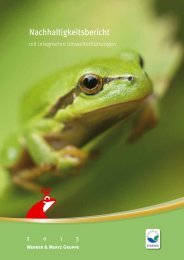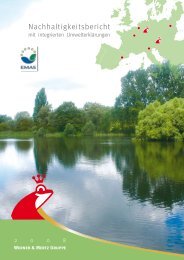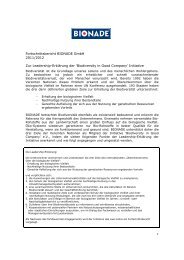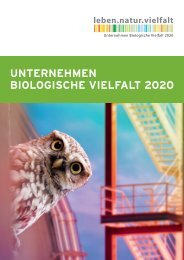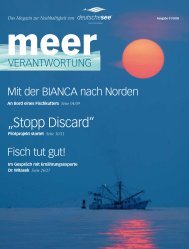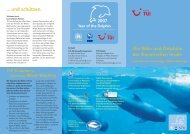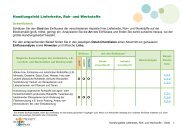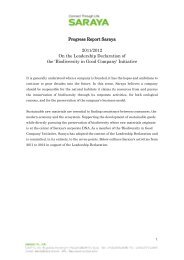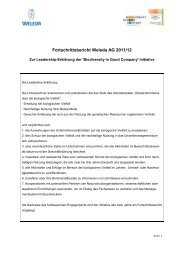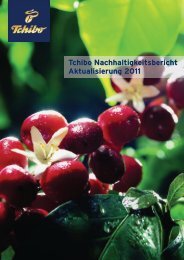Group guideline for the promotion of biodiversity - Business and ...
Group guideline for the promotion of biodiversity - Business and ...
Group guideline for the promotion of biodiversity - Business and ...
- No tags were found...
Create successful ePaper yourself
Turn your PDF publications into a flip-book with our unique Google optimized e-Paper software.
Contents1 Preface 32 Introduction 42.1 Biodiversity through TargetedManagement 42.2 Availability <strong>and</strong> Goals <strong>of</strong> this Guideline 53 HeidelbergCement <strong>and</strong> Biodiversity 63.1 The Impact <strong>of</strong> Mineral Extraction Siteson Biodiversity 63.2 Principles <strong>for</strong> <strong>the</strong> Promotion <strong>of</strong>Biodiversity 113.2.1 Encouraging Dialogue 113.2.2 Increasing Biodiversity 113.2.3 Protecting Nature <strong>and</strong> Environment 113.3 Biodiversity Ambitions 123.3.1 Ambitions 2009 123.3.2 Ambitions 2010 123.3.3 Ambitions 2012 123.3.4 Ambitions 2020 124.3 Best Practice <strong>for</strong> Project <strong>and</strong>Restoration Planning 165 Management Measures in OperatingExtraction Sites 176 Indicators <strong>for</strong> Measuring <strong>and</strong>Controlling Biodiversity 196.1 Biodiversity – A Core Topic <strong>for</strong>HeidelbergCement 196.2 Indicator Systems 206.2.1 HeidelbergCement Indicators 206.2.2 Global Reporting Initiative 226.2.3 Cement Sustainability Initiative 227 Stakeholder Dialogue 238 Bibliography 249 Glossary 2624 After-use 134.1 Foundations 134.2 Definitions 13
1PrefaceThe principle <strong>of</strong> sustainability is deep-seated in<strong>the</strong> company strategy <strong>of</strong> HeidelbergCement. Weprovide a safe <strong>and</strong> healthy work environment <strong>for</strong>our employees <strong>and</strong> take on responsibility at all ourlocations worldwide. We underst<strong>and</strong> sustainabilityto be a constant ef<strong>for</strong>t <strong>for</strong> improvements in <strong>the</strong>field <strong>of</strong> nature <strong>and</strong> environment protection. We doour best to keep <strong>the</strong> impact on <strong>the</strong> environment aslow as possible through good management at ourlocations.This <strong>Group</strong> <strong>guideline</strong> manifests <strong>the</strong> basic parameters<strong>for</strong> <strong>the</strong> <strong>promotion</strong> <strong>of</strong> <strong>biodiversity</strong> at our mineralextraction sites. This <strong>guideline</strong> aims at definingcon sistent st<strong>and</strong>ards <strong>for</strong> restoration <strong>and</strong> renaturation.These st<strong>and</strong>ards are to be deployed in all ourbusiness lines. Every after-use plan will take intoaccount <strong>the</strong> economic, ecological <strong>and</strong> social needs<strong>of</strong> <strong>the</strong> respective community. All intended <strong>for</strong>ms<strong>of</strong> after-use will support <strong>the</strong> preservation <strong>of</strong> speciesdiversity <strong>and</strong> contribute to raising <strong>the</strong> variety <strong>of</strong>plants <strong>and</strong> animals wherever possible.When extracting minerals, we change <strong>the</strong> l<strong>and</strong>scape<strong>and</strong> make use <strong>of</strong> mineral resources which havedeveloped over millions <strong>of</strong> years. Only if we manageto safeguard <strong>the</strong>se resources <strong>and</strong> h<strong>and</strong>le <strong>the</strong>m carefully,we will be able to meet our own dem<strong>and</strong>s <strong>and</strong>those <strong>of</strong> future generations. We have set ourselves<strong>the</strong> goal <strong>of</strong> sustainable <strong>and</strong> long-term economicgrowth. We will contribute to this goal significantlyby implementing this <strong>Group</strong> <strong>guideline</strong> consistently.3The Managing Board
2Introduction2.1 Biodiversity through Targeted ManagementIn roughly 50 countries around <strong>the</strong> world, <strong>the</strong> nameHeidelbergCement st<strong>and</strong>s <strong>for</strong> competence <strong>and</strong>quality. The international character <strong>of</strong> <strong>the</strong> companyimplies a worldwide responsibility <strong>for</strong> all <strong>of</strong> ouractivities. HeidelbergCement has a tradition <strong>of</strong> commitmentto sustainability, <strong>and</strong> builds on <strong>the</strong> threepillars: ecology, economy <strong>and</strong> social responsibility.Our sustainable management is centred aroundclients, employees, shareholders <strong>and</strong> local partnersat all locations.The quarries <strong>and</strong> gravel pits from which we extractour raw materials are valuable habitats <strong>for</strong> a variety<strong>of</strong> animal <strong>and</strong> plant species. The dynamic nature <strong>of</strong>quarrying attracts a wide range <strong>of</strong> rare species. Afteractivities <strong>the</strong>re have ceased, our mineral extractionsites are pr<strong>of</strong>essionally restored <strong>and</strong> returnedto a natural state, or prepared <strong>for</strong> agricultural useor <strong>for</strong>estry. Our emphasis on natural successionhas consistently increased over time, benefiting <strong>the</strong>development <strong>of</strong> broad <strong>biodiversity</strong>, adjusted to <strong>the</strong>native habitat.Our ambition is to strategically promote <strong>and</strong> conserve<strong>biodiversity</strong> at our mineral extraction sitesworldwide. To meet this goal, HeidelbergCement is<strong>the</strong> first company in <strong>the</strong> industry to adopt a <strong>Group</strong><strong>guideline</strong> <strong>for</strong> <strong>the</strong> <strong>promotion</strong> <strong>of</strong> <strong>biodiversity</strong> atmineral extraction sites. With immediate effect this<strong>guideline</strong> will be valid at all our locations throughoutEurope. It is <strong>the</strong> basis <strong>for</strong> systematic implementation<strong>of</strong> consistent measures, as well as <strong>the</strong>realisation <strong>of</strong> our <strong>biodiversity</strong> ambitions.The core <strong>of</strong> <strong>the</strong> <strong>guideline</strong> comprises ten principlesgeared towards promoting dialogue with keystakeholders, as well as increasing biologicaldiversity during <strong>and</strong> after quarrying, in orderto protect <strong>the</strong> native l<strong>and</strong>scape <strong>and</strong> ecology. Inaddition, <strong>the</strong> <strong>guideline</strong> defines ambitious targetsHeidelbergCement aims to successively achieveby 2020. It also sets out decisive principles <strong>for</strong>modern, pr<strong>of</strong>essional restoration, which significantlycontribute to <strong>the</strong> <strong>promotion</strong> <strong>of</strong> <strong>biodiversity</strong>.4
2.2 Availability <strong>and</strong> Goals <strong>of</strong> this GuidelineThis <strong>guideline</strong>, as well as many good practice examplesas PDF-documents in <strong>the</strong> internet <strong>and</strong> intranet<strong>of</strong> HeidelbergCement, provides an all-embracingintroduction to <strong>the</strong> specific new orientation <strong>of</strong> <strong>the</strong>company regarding ”extraction sites <strong>and</strong> biologicaldiversity” <strong>for</strong> employees <strong>and</strong> <strong>the</strong> public. This <strong>guideline</strong>is to be effective at our locations in Europe.Its worldwide implementation is currently beingprepared.For internal use <strong>the</strong>re is an elaborate long versiondescribing <strong>the</strong> restoration <strong>of</strong> distinct habitats.The general advice in this <strong>guideline</strong> cannot beimplemen ted completely in each <strong>and</strong> every extractionsite. Thus it needs to be implemented usingconcerted action, taking mining needs as well aseconomic factors into account according to <strong>the</strong>specific conditions on location.The future orientation <strong>of</strong> after-use planning is basedon <strong>the</strong> following goals:■■ This <strong>guideline</strong> aims at defining <strong>Group</strong>-wide globalminimum st<strong>and</strong>ards <strong>for</strong> <strong>the</strong> restoration <strong>of</strong> mineralextraction sites, encompassing cement <strong>and</strong> aggregatesas business lines.■■ All <strong>for</strong>ms <strong>of</strong> after-use ought to contribute to <strong>the</strong>preservation <strong>of</strong> biological diversity <strong>and</strong> to increase<strong>biodiversity</strong> where possible. Fur<strong>the</strong>rmore, <strong>the</strong>yought to be sustainable, long-lasting <strong>and</strong> efficientlyusable <strong>for</strong> human beings.■■ The global goal <strong>of</strong> after-use planning <strong>for</strong> eachmineral extraction site is to reach a balancebetween economic, ecological <strong>and</strong> socialrequirements.■■ In order to take into account <strong>the</strong> distinctive bio-logical diversity features <strong>of</strong> <strong>the</strong> individual countries<strong>and</strong> continents, <strong>the</strong> <strong>guideline</strong> will successivelybecome more detailed <strong>and</strong> will be adaptedto <strong>the</strong> specific dem<strong>and</strong>s <strong>of</strong> various geographicareas by 2010.Biodiversity isincreasingMineralextractionextraction are diminshedIndicators <strong>for</strong> measuring<strong>biodiversity</strong>Effects <strong>of</strong> mineralBiodiversityAction Plans(BAP)Compensation needsare decreasingBiodiversity isincreasingAfter-useIndicators <strong>for</strong> measuring<strong>biodiversity</strong>5
3HeidelbergCement <strong>and</strong> Biodiversity3.1 The Impact <strong>of</strong> Mineral Extraction Sites onBiodiversityNature <strong>and</strong> l<strong>and</strong>scapes have become increasinglyexposed to a rapidly growing world population<strong>and</strong> an increasing utilisation impact over <strong>the</strong> lastdecades. This has lead to a considerable <strong>and</strong> everincreasing loss <strong>of</strong> animal <strong>and</strong> plant species worldwideas habitats are ei<strong>the</strong>r chopped up or lostcompletely. Mineral extraction sites in particular arefrequently regarded as destructive to <strong>the</strong> environment<strong>and</strong> <strong>the</strong>re<strong>for</strong>e still present a predominantlynegative image <strong>for</strong> <strong>the</strong> public <strong>and</strong> nature conservationorganisations <strong>and</strong> authorities. Despite massiveef<strong>for</strong>ts <strong>of</strong> <strong>the</strong> industry to restore mineral extractionsites, <strong>the</strong> resentment remains unbroken to a largeextent <strong>and</strong> poses serious problems <strong>for</strong> <strong>the</strong> provision<strong>of</strong> raw materials <strong>and</strong> future mineral extractionplanning.Scientific DataThis general disapproval is opposed by an underst<strong>and</strong>ingwhich has arisen since <strong>the</strong> end <strong>of</strong> <strong>the</strong>1970s, namely that mineral extraction sites whichhave been closed down may take on importantfunctions in <strong>the</strong> environment <strong>of</strong> intensely utilisedl<strong>and</strong> cultivated by man. Closed down mineralextraction sites which have not been restored bytopsoil application, sowing <strong>and</strong> plantation, contributeto sustainably increase <strong>and</strong> safeguard <strong>biodiversity</strong>just through <strong>the</strong> existence <strong>of</strong> habitats significantwithin a habitat network system. They also stabilise<strong>the</strong> surrounding ecosystems. Closed down quarriescontain high numbers <strong>of</strong> species with a high share<strong>of</strong> endangered animal <strong>and</strong> plant species. Variousmanifestations <strong>of</strong> habitat types appear meshed<strong>the</strong>re, many <strong>of</strong> which are endangered, rare orthreatened. This diversity is caused by long periods<strong>of</strong> development hardly ever influenced or disturbedby man. Thus a great variety <strong>of</strong> locations <strong>and</strong> structureshave developed.Research in <strong>the</strong> last two decades has proven convincingly,with a broad specialist foundation, thatthis insight also applies to operating extraction sites.They are characterised by a high number <strong>of</strong> animal<strong>and</strong> plant species, many <strong>of</strong> which are endangered(Figure 1). The findings are frequently comparableor even higher than in most habitats <strong>of</strong> <strong>the</strong> surroundings.This is due to <strong>the</strong> extreme environmentalconditions in <strong>the</strong> extraction sites <strong>and</strong> <strong>the</strong>ir greathabitat conditions. Characteristic habitats are e. g.6Biological diversityBiological diversity – or <strong>biodiversity</strong> – is one <strong>of</strong> <strong>the</strong> keywords in natureconservation. It refers to <strong>the</strong> ”abundance <strong>of</strong> life <strong>and</strong> its manifold structures“(European Commission).The term biological diversity st<strong>and</strong>s <strong>for</strong> more than <strong>the</strong> diversity <strong>of</strong> species,however. According to <strong>the</strong> Convention on Biological Diversity (CBD),<strong>biodiversity</strong> encompasses■■ <strong>the</strong> diversity <strong>of</strong> species on earth (organism level),■■ genetic diversity (diversity <strong>of</strong> genes within a species),■■ diversity <strong>of</strong> habitats (ecosystem level).Figure 1: Young initial vegetation at quarrying level
ock faces (Figure 2), perennial bodies <strong>of</strong> water,temporary bodies <strong>of</strong> water as <strong>for</strong> instance in tracks<strong>and</strong> <strong>the</strong> refuse <strong>and</strong> spoil heaps (Figure 3, Figure 4).Figure 2: Colony <strong>of</strong> s<strong>and</strong> martins in old riverbed sediments in a steep face <strong>of</strong> an extraction siteComparison <strong>of</strong> <strong>the</strong> factors accounting <strong>for</strong> <strong>the</strong> natureconservation significance <strong>of</strong> closed down <strong>and</strong> operatingquarries:Operating quarrieshigh diversity <strong>of</strong> structures <strong>and</strong> locationsrare habitat conditions at <strong>the</strong> locationvery high numbers <strong>of</strong> speciesnumber <strong>of</strong> endangered species almost alwayshigher than that <strong>of</strong> most habitats in <strong>the</strong> surroundingsrare <strong>and</strong> endangered vegetation types, predominantlyprotosoil <strong>and</strong> pioneer locations7Figure 3: The areas are colonised quicklyClosed down quarrieshigh diversity <strong>of</strong> structures <strong>and</strong> locationsrare habitat conditions at <strong>the</strong> locationhigh numbers <strong>of</strong> speciesnumber <strong>of</strong> endangered species very high,partly higher than in <strong>the</strong> surroundingsrare <strong>and</strong> endangered vegetation types in various<strong>for</strong>msFigure 4: Young body <strong>of</strong> water as habitat <strong>for</strong> specialised animals <strong>and</strong> plants
Figure 5: Variegated coexistence <strong>of</strong> w<strong>and</strong>erbiotopes close to ongoing extractionFigure 6: Near-natural rock faceFigure 7: Temporary water bodies at quarrying levelW<strong>and</strong>erbiotopesExtraction sites are very important <strong>for</strong> <strong>the</strong> protection<strong>of</strong> species <strong>and</strong> habitats due to <strong>the</strong> variety <strong>of</strong> subhabitatsinterlocked at small-scale or <strong>the</strong> developmentareas <strong>for</strong> animals <strong>and</strong> plants <strong>of</strong> different ageswithin spatial <strong>and</strong> temporal interrelations (Figure 5).The combination <strong>of</strong> sometimes extreme contrastsin habitat conditions, which can hardly be foundor not be found at all in <strong>the</strong> surrounding cultivatedl<strong>and</strong>scape, have developed into a great structuralvariety that is a prerequisite <strong>for</strong> <strong>the</strong> establishment <strong>of</strong>numerous plant <strong>and</strong> animal species (Figure 6).The bare shallow temporary water bodies in <strong>the</strong>tracks <strong>of</strong> heavy duty lorries, which can appear withina very short time during <strong>the</strong> extraction process,are typical w<strong>and</strong>erbiotopes <strong>for</strong> amphibians such as<strong>the</strong> yellow-bellied toad (Bombina variegata) or <strong>the</strong>green toad (Bufo calamita) (Figure 7, Figure 8). Thelittle ringed plover (Charadrius dubius) likes to settleon almost bare spacious stone leas, pebble leas orprotosoil leas, but only during ongoing extraction<strong>and</strong> with temporary water bodies close by. Numerouscliff breeders such as <strong>the</strong> eagle owl (Bubo bubo)or <strong>the</strong> peregrine falcon (Falco peregrinus) use <strong>the</strong>quarry faces <strong>for</strong> breeding as long as <strong>the</strong>re are suitablealcoves <strong>and</strong> as long as <strong>the</strong> walls do not erodetoo quickly due to s<strong>of</strong>t rock material such as marl.Whenever <strong>the</strong> mining works move away from afreshly carved out quarry face, <strong>the</strong> birds settle fairlyquickly, if <strong>the</strong> structure is suitable. They may evenhatch only a few dozen metres away from ongoingextraction works.The differences in flora are similarly obvious. Wetl<strong>and</strong>habitats <strong>and</strong> topsoil or spoil dumps are specious-richw<strong>and</strong>erbiotopes <strong>for</strong> many plant species<strong>and</strong> are settled very quickly (Figure 9, Figure 10),while dry or temporarily dry clay habitats need more8
Figure 8: Temporary body <strong>of</strong> water – photographed in 1992time until <strong>the</strong>y become settled to a relevant extentdue to <strong>the</strong> more extreme habitat conditions(Figure 11, Figure 12).The extraction sites are characterised by pronounceddynamics. A comparison <strong>of</strong> old photographsto <strong>the</strong> current state proves how fast <strong>the</strong>sepresumably nutrient-poor protosoil locations aresettled by specialised species (Figure 8, Figure 9).Modern extraction planning regards <strong>the</strong>se results asan opportunity <strong>for</strong> new restoration <strong>and</strong> renaturationconcepts. Dynamic processes get integrated <strong>and</strong><strong>the</strong> after-use is adapted accordingly. Existing speciespopulations are taken into account <strong>and</strong> habitats areoptimised. The following chapters provide directionson how <strong>the</strong> various interests <strong>for</strong> <strong>the</strong> after-use canbe balanced, while <strong>biodiversity</strong> is promoted at <strong>the</strong>same time.9Fur<strong>the</strong>r ReadingDav i s (1977; 1979; 1981a; b); Tr ä n k l e 1997; 2000;Bö h m e r & Ra h m a n n (1997); Gi lc h e r & Br u n s 1999;Rademacher (2001); BDZ/VDZ (2001; 2003).Figure 9: The same body <strong>of</strong> water in 2006W<strong>and</strong>erbiotopesSpatial changes within <strong>the</strong> extraction areas may create areas predestined <strong>for</strong> <strong>the</strong> development <strong>of</strong> animals<strong>and</strong> plants. They are <strong>of</strong> various ages, show different structures <strong>and</strong> are closely connected to one ano<strong>the</strong>r(succession zones). Whenever minerals are extracted once again from one <strong>of</strong> <strong>the</strong>se areas, a substitute hasalready developed elsewhere. These habitats thus ”w<strong>and</strong>er“, as <strong>the</strong> plants <strong>and</strong> animals w<strong>and</strong>er from oneend <strong>of</strong> <strong>the</strong> extraction site to <strong>the</strong> o<strong>the</strong>r. These succession zones which are continually renewed are calledw<strong>and</strong>erbiotopes.
Figure 10: Settlement <strong>of</strong> a sedimentation basin10Figure 12: Succession areas on spoil dumpsFigure 8: Initial reeds in wetl<strong>and</strong> areaFigure 11: Near-naturally settled belay
3.2 Principles <strong>for</strong> <strong>the</strong> Promotion <strong>of</strong> Biodiversity3.2.1 Encouraging Dialogue■■ HeidelbergCement promotes <strong>the</strong> increase <strong>of</strong><strong>biodiversity</strong> in <strong>the</strong> planning <strong>and</strong> implementation<strong>of</strong> restoration through a structured approach, indialogue with all stakeholders.■■ The <strong>for</strong>ms <strong>of</strong> after-use are to be discussed wi<strong>the</strong>nvironmental authorities, nature conservationorganisations <strong>and</strong> o<strong>the</strong>r interested parties.3.2.2 Increasing Biodiversity■■ Each mineral extraction site should maximise <strong>the</strong>l<strong>and</strong> area with ecological value.■■ The ecological <strong>and</strong> economic value <strong>of</strong> l<strong>and</strong> afteruseneed to be fully considered as <strong>the</strong>y both can<strong>for</strong>ward <strong>the</strong> <strong>promotion</strong> <strong>of</strong> <strong>biodiversity</strong>.■■ The planning <strong>and</strong> implementation <strong>of</strong> subsequentafter-use will be carried out by specialists.■■ HeidelbergCement promotes a high degree <strong>of</strong><strong>biodiversity</strong> even in working quarries. Areas temporarilyout <strong>of</strong> use should be managed to maximiseecological benefit.■■ Certain areas <strong>of</strong> each quarry should be left todevelop naturally.3.2.3 Protecting Nature <strong>and</strong> Environment■■ Indigenous <strong>and</strong> regionally typical plant specieswill be favoured.■■ It is imperative to protect <strong>the</strong> topsoil <strong>and</strong> subsoil.Soil resources need to be safeguarded, protectedfrom erosion <strong>and</strong> to be ei<strong>the</strong>r reused as soon aspossible on restoration areas or to be stored <strong>for</strong> atransitional period to avoid damage or loss.■■ Ground water <strong>and</strong> surface water must not becontaminated ei<strong>the</strong>r during work or after-use.11
3.3 Biodiversity Ambitions3.3.1 Ambitions 2009■■ This <strong>guideline</strong> will be fur<strong>the</strong>r developed using aninternal adjustment process in all points necessary<strong>and</strong> it will be made tangible on country orcontinental level.■■ A compilation <strong>of</strong> o<strong>the</strong>r current or recentbest practice projects <strong>of</strong> <strong>the</strong> company will beaccomplished.■■ Fur<strong>the</strong>r mineral extraction sites will be includedinto <strong>the</strong> monitoring system <strong>for</strong> <strong>biodiversity</strong> inconsideration <strong>of</strong> action plans.in <strong>the</strong> monitoring system <strong>for</strong> <strong>biodiversity</strong> in consideration<strong>of</strong> action plans.■■ The percentage <strong>of</strong> mineral extraction sites withan effective restoration plan will be increased to85 %.3.3.3 Ambitions 2012■■ The percentage <strong>of</strong> mineral extraction sites withan effective restoration plan will be increased to90 %.■■ Fur<strong>the</strong>r mineral extraction sites will be includedin <strong>the</strong> monitoring system <strong>for</strong> <strong>biodiversity</strong> in consideration<strong>of</strong> action plans.123.3.2 Ambitions 2010■■ The final version <strong>of</strong> this <strong>guideline</strong> will be available.■■ The implementation will begin on country level,<strong>for</strong> instance through training courses <strong>and</strong> <strong>the</strong>provision <strong>of</strong> training materials.■■ Integration <strong>of</strong> <strong>the</strong> <strong>guideline</strong> into <strong>the</strong> environmentalmanagement systems will be achieved.■■ Fur<strong>the</strong>r mineral extraction sites will be included3.3.4 Ambitions 2020■■ The percentage <strong>of</strong> mineral extraction sites withan effective restoration plan will be increased to100 %.■■ Active exploitations within or adjacent to areasdesignated <strong>for</strong> <strong>the</strong>ir high <strong>biodiversity</strong> value haveactively implemented <strong>biodiversity</strong> managementplans <strong>and</strong> <strong>biodiversity</strong> monitoring.
4After-use4.1 FoundationsThe extraction <strong>of</strong> minerals always leaves hollowmoulds all <strong>of</strong> kinds, be <strong>the</strong>y in <strong>the</strong> shape <strong>of</strong> a funnelor a box-hole, in <strong>the</strong> <strong>for</strong>m <strong>of</strong> <strong>of</strong>fsetting mountainsidesor exp<strong>and</strong>ing valleys, no matter if with or withoutwater, steep rock faces, flat dumps or terracedwith excavation beds. These artificial <strong>for</strong>ms shouldbe integrated into <strong>the</strong> l<strong>and</strong>scape after <strong>the</strong> quarryingends. They ought to be utilisable <strong>and</strong> left to naturalresettlement. And so <strong>the</strong>y are, already today. The resettlement<strong>of</strong> nature <strong>and</strong> l<strong>and</strong>scapes is <strong>the</strong> last step<strong>of</strong> mining work. The term restoration points out <strong>the</strong>reference to <strong>the</strong> surrounding l<strong>and</strong>scape – <strong>the</strong> extractionsite needs to be fitted into <strong>the</strong> surroundingl<strong>and</strong>scape <strong>and</strong> nature so that it will be integratedcompletely. There<strong>for</strong>e, restoration requires focusedl<strong>and</strong>scape analysis. Then <strong>the</strong>re are <strong>the</strong> varied wishes<strong>of</strong> <strong>the</strong> population <strong>for</strong> <strong>the</strong> after-use. All <strong>the</strong>se actualities,wishes <strong>and</strong> dem<strong>and</strong>s, including taking intoaccount <strong>the</strong> call <strong>for</strong> more <strong>biodiversity</strong>, need to beintegrated in a reasonable after-use concept. Theoverall goal is <strong>the</strong> recreation <strong>of</strong> rare, near-naturalhabitats typical <strong>for</strong> <strong>the</strong> kind <strong>of</strong> excavation <strong>and</strong> ecologicallysignificant. This encompasses establishingagricultural or <strong>for</strong>estry areas <strong>and</strong> settlement plotswherever reasonable. Fields, meadows, commercial<strong>for</strong>ests <strong>and</strong> settlements will be located in <strong>the</strong>places best suitable, meaning <strong>the</strong> flat areas. Nearnaturalhabitats will conquer <strong>the</strong> steep parts <strong>of</strong> <strong>the</strong>l<strong>and</strong>scape, which are less apt <strong>for</strong> human usage. Theconceptual aims <strong>and</strong> <strong>the</strong> planning <strong>of</strong> <strong>the</strong> restorationmeasures have to meet <strong>the</strong>se dem<strong>and</strong>s as well aspossible <strong>and</strong> with as little conflict as possible.The priority <strong>of</strong> our conceptual aims is <strong>the</strong> maintenance<strong>and</strong> <strong>promotion</strong> <strong>of</strong> biological diversity.Depending on <strong>the</strong> specific surroundings <strong>of</strong> eachextraction site, <strong>the</strong> restoration or <strong>the</strong> renaturationareas will prevail. It is on <strong>the</strong> agenda <strong>of</strong> Heidelberg-Cement to integrate areas within each extractionsite, which contribute to <strong>biodiversity</strong>. Their share issupposed to increase gradually depending on <strong>the</strong>local conditions.4.2 DefinitionsThe way we define restoration <strong>and</strong> o<strong>the</strong>r termsused in this context is already predetermined by<strong>the</strong> measures <strong>and</strong> ambitions we decided to put intopractice. There are however considerable differencesin <strong>the</strong> way different countries underst<strong>and</strong>13
certain terms. Because <strong>the</strong> practical usage <strong>of</strong> termson site locally differs from <strong>the</strong> scientific terminology,we would like to explain <strong>the</strong> most important termsbriefly in this chapter.RestorationRestoration means reestablishing <strong>the</strong> original ecosystem,<strong>the</strong> habitat or <strong>the</strong>ir functions in <strong>the</strong> undisturbedway in which <strong>the</strong>y originally existed, includingbiological, chemical <strong>and</strong> physical elements.ReclamationReclamation is <strong>the</strong> reconditioning <strong>for</strong> agriculturalends or <strong>the</strong> reestablishing <strong>of</strong> <strong>the</strong> natural scenery.In most cases, <strong>the</strong> original soil as well as <strong>the</strong> originalvegetation do not exist any more, but have to bereconditioned through soil application, fertilisation<strong>and</strong> sowing.The term recultivation is predominantly used in Europe<strong>and</strong> mostly in connection with extraction sites.RecreationRecreation implies that it is not necessary to reestablish<strong>the</strong> exact same ecosystem as existed be<strong>for</strong>e<strong>the</strong> extraction work. It means that it is enough tocreate an ecological system <strong>of</strong> any kind. It is importanthowever, that this ecosystem is ecologicallysignificant.RenaturationRenaturation means <strong>the</strong> resettlement <strong>of</strong> man-madelocations as, <strong>for</strong> instance, extraction sites (or <strong>of</strong>ecosystems influenced by men) through plants <strong>and</strong>animals. This leads to habitats autochthonous <strong>for</strong><strong>the</strong> location <strong>and</strong> its climate. Renaturation is closelyconnected to reaching a high level <strong>of</strong> biologicaldiversity.Three <strong>for</strong>ms can be distinguished on <strong>the</strong> basis <strong>of</strong> <strong>the</strong>intensity <strong>of</strong> human influence:■■ Renaturation goes on without initiation or humanregulation. We call this independent processnatural succession.■■ Renaturation is initiated by strategic planning <strong>and</strong>practical measures, which accelerate <strong>the</strong> processat least in <strong>the</strong> beginning. This process can becategorised as natural succession as well.■■ The course <strong>of</strong> renaturation is systematicallychanged <strong>and</strong> controlled through planning, planting<strong>and</strong> subsequent maintenance. Controlledrenaturation is very similar to restoration.14SuccessionIn ecology, succession denotes <strong>the</strong> chronology <strong>of</strong> plant <strong>and</strong> animal communities at one location in <strong>the</strong>progress <strong>of</strong> time. During a succession process, an ecosystem goes through a climax from an initial statecontaining only few species up to a nearly stable final species-rich stage. The areas change quickly in akaleidoscopic way.Free succession is <strong>the</strong> settlement <strong>of</strong> areas without any human supporting measures.Controlled succession means that human support only takes place in <strong>the</strong> beginning in order to accelerate<strong>the</strong> first settlements by introducing initial species.
Rehabilitation, Reintroduction, Reestablishing<strong>and</strong> Habitat ImprovementThe following terms differ inherently in <strong>the</strong>ir quality,but have distinct intersections in common. They allaim at improving a habitat type. The first three termsare aspects <strong>of</strong> restoration.Rehabilitation: Rehabilitation is <strong>the</strong> restoration orimprovement <strong>of</strong> certain aspects or functions <strong>of</strong> anecosystem or habitat. It does not necessarily imply<strong>the</strong> complete restoration <strong>of</strong> an ecosystem or habitat.Reintroduction: Reintroduction implies that onlysmall parts <strong>of</strong> an ecosystem are substituted <strong>and</strong> not<strong>the</strong> whole ecosystem. Certain species are introducedinto an existing, established, i.e. functioningecosystem.Reestablishing: Reestablishing comprises only <strong>the</strong>targeted reintroduction <strong>of</strong> plants <strong>and</strong> animals, <strong>for</strong>instance through sowing or planting or throughcatching <strong>and</strong> releasing in order to increase biologicaldiversity.Habitat Improvement: The improvement <strong>of</strong> habitatfactors such as hydrological, physical or chemicalconditions <strong>for</strong> instance by targeted fertilisation canenhance <strong>the</strong> quality <strong>of</strong> a habitat.Fur<strong>the</strong>r ReadingBr a d s h a w (1977); Ca i r n s & Ca i r n s Jr. (1995); Go r e(1985); Ka n g a s (2004); Kauffman et al. (1997); Nati o n a l Research Co u n c i l (1992); Pfadenhauer & Ma a s(1991); Pfadenhauer (1990); Ra n a (1998); Ro n i et al.(2005); Tr ä n k l e et al. (1992).Autochthonous speciesDomestic species have or used to have a naturalrange extending partly over a whole nation.Species which were introduced by man<strong>and</strong> returned to <strong>the</strong> wild do not belong in thiscategory.We speak <strong>of</strong> indigenous or autochthonousspecies if <strong>the</strong>y <strong>for</strong>m genetically adapted tribesin one bio-geographic region. Such species arewell-adapted to <strong>the</strong> regional environmentalconditions.We speak <strong>of</strong> autochthonous species if <strong>the</strong>y havesettled at a certain location due only to ecologicalprinciples – uninfluenced by man. In most cases<strong>the</strong> term autochthonous is used as a synonym <strong>of</strong><strong>the</strong> term indigenous.15
4.3 Best Practice <strong>for</strong> Project <strong>and</strong> RestorationPlanningThe operation <strong>and</strong> extension <strong>of</strong> extraction sitesinevitably leads to using up l<strong>and</strong>scape areas. Theemissions <strong>and</strong> immissions resulting from quarryingaffect nature <strong>and</strong> <strong>the</strong> environment. There<strong>for</strong>e,HeidelbergCement aims at following good pr<strong>of</strong>essionalpractice all around <strong>the</strong> world <strong>for</strong> all processes,be <strong>the</strong>y planning, quarrying or restoring. It is essentialat planning stages to always check environmentalcompatibility. Employing a framework concept <strong>for</strong>after-use (UVU, EIA) is a minimal requirement.Good pr<strong>of</strong>essional practice needs to contain <strong>the</strong>following four essential steps:■■ Detailed project planning in <strong>the</strong> run-up; all relevantnatural <strong>and</strong> environmental factors need tobe regarded including human beings.■■ Analysing <strong>and</strong> examining <strong>the</strong> environmental compatibility;<strong>the</strong> impact on <strong>the</strong> environment needsto be avoided or minimised at best.■■ The extraction phase.■■ Restoration concentrating on a high level <strong>of</strong> biologicaldiversity in all areas exploited.The last point, <strong>the</strong> actual restoration <strong>of</strong> habitat types,contains <strong>the</strong> following basic steps:■■ Choice <strong>of</strong> location.■■ Developing a framework restoration plan underregional sustainability aspects (text <strong>and</strong> map).■■ Developing a detailed restoration plan (text <strong>and</strong>map).■■ Providing adequate habitat conditions.■■ Maintenance.■■ Monitoring.It is essential to keep <strong>the</strong> public adequatelyin<strong>for</strong>med during <strong>the</strong> whole process.In numerous countries <strong>the</strong>re are already legal regulationsregarding restoration, but only some provideadditional <strong>guideline</strong>s or directives on how to h<strong>and</strong>le<strong>the</strong> whole planning process. Thus we list <strong>the</strong> mostimportant documents to be consulted here:■■ COP 6 Decisions, The Hague, 7 - 19 April 2002:Decision IV/7: Identification, monitoring, indicators<strong>and</strong> assessments■■ IAIA Headquarter (1998): Environmental MethodsReview: Retooling Impact Assessment <strong>for</strong> <strong>the</strong>New Century. Edited by Alan L. Porter <strong>and</strong> JohnJ. Fittipaldi. Fargo, North Dakota, USA: The PressClub. March 1998. 309p.■■ Council Directive (27 June 1985) on <strong>the</strong> assessment<strong>of</strong> <strong>the</strong> effects <strong>of</strong> certain public <strong>and</strong> privateprojects on <strong>the</strong> environment (85/337/EEC).The Council <strong>of</strong> <strong>the</strong> European Communities(as ammended from time to time).■■ Vanclay, F.; Bronstein, D. A. (1995): Environmental<strong>and</strong> Social Impact Assessment. JohnWiley <strong>and</strong> Sons Ltd. Hrsg.: Vanclay, F.; Bronstein,D. A. ISBN-10: 047195764X, ISBN-13: 978-0471957645. 352p.■■ World <strong>Business</strong> Council <strong>for</strong> Sustainable Development(WBCSD) (2005): Environmental <strong>and</strong> socialimpact assessment (ESIA) <strong>guideline</strong>s. L<strong>and</strong> <strong>and</strong>communities. Version 1.0. April 2005. wbcsd@earthprint.com. 52p.16
5Management Measures in Operating Extraction SitesMany extraction sites possess species-rich communitieswith numerous rare plants <strong>and</strong> animalswithout anyone’s help even during <strong>the</strong> ongoingquarrying. The <strong>biodiversity</strong> is considerable. It ispossible, however, to fur<strong>the</strong>r enhance <strong>and</strong> preservebiological diversity by comparatively simple measureswithout disturbing <strong>the</strong> mining activity. In thisway HeidelbergCement’s ambitions <strong>for</strong> sustainabilityare supported throughout <strong>the</strong> <strong>Group</strong>.The following general advice cannot be implementedcompletely in each <strong>and</strong> every extraction site.Thus it needs to be implemented using concertedaction, taking mining needs as well as economicfactors into account according to <strong>the</strong> specific conditionson location.Alternating Operation <strong>of</strong> Extraction SitesAn alternating operation <strong>of</strong> <strong>the</strong> extraction work isespecially favourable <strong>for</strong> <strong>biodiversity</strong>. It will generallyonly be realistic in bigger extraction sites. It meansthat <strong>the</strong> extraction should alternate in location – noteverywhere at <strong>the</strong> same time, unless geological factorsprevent this or <strong>the</strong> storing <strong>of</strong> <strong>the</strong> raw materialsis problematic. In an alternating exploitation site,w<strong>and</strong>erbiotopes can develop (long-term pacifiedareas) with <strong>the</strong>ir highly specialised habitats <strong>and</strong>numerous rare plant <strong>and</strong> animal species.If habitats with endangered species have developedwithin an extraction site <strong>and</strong> <strong>the</strong>se areas are needed<strong>for</strong> fur<strong>the</strong>r extraction, <strong>the</strong>y may be relocated.Temporary Establishment <strong>of</strong> HabitatsAutochthonous species can be sown or <strong>the</strong> developmentconcept ”distribution <strong>of</strong> freshly cut grass”can be implemented on parts <strong>of</strong> areas not used<strong>for</strong> a longer period <strong>of</strong> time. The establishment <strong>of</strong> atemporary habitat will result in <strong>the</strong> immigration <strong>of</strong>parts <strong>of</strong> <strong>the</strong> species into <strong>the</strong> succession areas <strong>of</strong> <strong>the</strong>quarry. This will enhance <strong>the</strong> biological diversity in<strong>the</strong> whole extraction site. Only autochthonous seedfrom specialised commercial plant centres ought tobe used <strong>for</strong> sowing, however.Establishment <strong>of</strong> Rest ZonesAreas, which are presumably not operated anylonger, should be outsourced at an early point <strong>of</strong>time. This means that <strong>the</strong>se areas nei<strong>the</strong>r get passedover nor used as storage areas or rack. In <strong>the</strong>se restzones <strong>the</strong> first species immigrate, which can settle<strong>the</strong> o<strong>the</strong>r areas after <strong>the</strong> complete closure <strong>of</strong> <strong>the</strong>17
quarry. It is advisory to mark shallow dry areas orareas with temporary waters as rest zones. Rocks<strong>and</strong> steep faces may even be excluded from quarrying<strong>for</strong> a while. The separation <strong>of</strong> such rest zonesfrom areas still active is achieved by ramparts made<strong>of</strong> spoil, by large rocks or linearly stapled wood clippings.This allows specialised habitat communitiesto develop slowly.Selective Promotion <strong>of</strong> SpeciesThe more cavities <strong>and</strong> holes in <strong>the</strong> plant buildingswhere birds can slip in, <strong>the</strong> more animal speciescan benefit. Animals such as bats or birds, <strong>and</strong> withsome exceptions also reptiles <strong>and</strong> insects, shouldalways be tolerated unless <strong>the</strong>y provide any kind <strong>of</strong>danger <strong>for</strong> <strong>the</strong> staff. Special nesting aids on buildings,rock faces or in woods may lure in designatedspecies.Soil ManagementAdvice on soil management be<strong>for</strong>e, during <strong>and</strong> afterquarrying is provided in section 4.4.After-use PlanningInflexible prescription <strong>and</strong> implementation <strong>of</strong>after-use planning needs to be replaced by a moreflexible h<strong>and</strong>ling <strong>of</strong> after-use concepts. This makesit possible to take spontaneous development<strong>of</strong> biological diversity into account on site after<strong>the</strong> cessation <strong>of</strong> quarrying <strong>and</strong> when it comes toreclamation.Fur<strong>the</strong>r ReadingBDZ/VDZ (2002); Dav i s (ed.) (1981); Tr ä n k l e &Beisswenger (1999).18
6Indicators <strong>for</strong> Measuring <strong>and</strong> Controlling Biodiversity6.1 Biodiversity – A Core Topic <strong>for</strong>HeidelbergCementConservation, <strong>promotion</strong> <strong>and</strong> reconstitution <strong>of</strong><strong>biodiversity</strong> has become <strong>the</strong> most important goal<strong>of</strong> sustainable development world-wide. This wasemphasised by <strong>the</strong> results <strong>of</strong> <strong>the</strong> UN World Summiton Sustainable Development in Johannesburg inAugust/September 2002. By 2010 <strong>the</strong> extinction <strong>of</strong>species is to be significantly slowed down as well as<strong>the</strong> diversity <strong>of</strong> fauna <strong>and</strong> flora to be retained.What is Biodiversity?Biodiversity is <strong>the</strong> abundance <strong>of</strong> life <strong>and</strong> <strong>the</strong> factorsthat account <strong>for</strong> it.Biodiversity encompasses <strong>for</strong> instance:■■ The number <strong>of</strong> plants <strong>and</strong> animals per area, perecosystem, per habitat, per vegetation unit, perbiocoenosis, per phytocoenosis, per zoocoenosis.■■ The number <strong>of</strong> vegetation units <strong>and</strong> types, <strong>of</strong>habitat types, <strong>of</strong> phytocoenosis <strong>and</strong> zoocoenosisper spatial unit.■■ The genetic diversity: <strong>the</strong> number <strong>of</strong> eco-breeds<strong>and</strong> eco-clines <strong>and</strong> <strong>the</strong> number <strong>of</strong> morphobreeds.■■ The number <strong>and</strong> length <strong>of</strong> structural elements<strong>and</strong> units (stepping-stone habitats) per spatialunit (this was <strong>the</strong> basis <strong>for</strong> <strong>the</strong> development <strong>of</strong><strong>the</strong> habitat network concept).■■ The number <strong>and</strong> <strong>the</strong> amount <strong>of</strong> eco-tone effects.HeidelbergCement Makes BiodiversityMeasurableNumerous studies within <strong>the</strong> last two decadeshave shown that not only extraction sites whichhave closed down but also those which are stilloperating <strong>and</strong> show a high degree <strong>of</strong> <strong>biodiversity</strong>.Extraction sites are thus centres <strong>of</strong> <strong>biodiversity</strong>despite <strong>the</strong> undisputable negative effects on nature<strong>and</strong> environment. There<strong>for</strong>e extraction sites haveto be preserved while <strong>the</strong>y are still operating, aswell as in <strong>the</strong> after-use period in <strong>the</strong> sense <strong>of</strong>global ef<strong>for</strong>ts.So-called indicators, especially <strong>biodiversity</strong> indicatorsare <strong>the</strong> appropriate instruments to make <strong>the</strong>development in <strong>the</strong> extraction sites qualitatively <strong>and</strong>quantitatively measurable, rateable <strong>and</strong> controllablewith regard to sustainability.Sustainable Development Indicators (SDI) <strong>for</strong>measuring <strong>biodiversity</strong> are also called BiodiversityIndicators (BI).The term” indicator“ derives from <strong>the</strong> Latin verb”indicare“ which can be translated as ”to show“ or”to betray“. The call <strong>for</strong> implementing sustainabilityindicators is based on chapter 40 <strong>of</strong> ”Agenda 21“(UNCED, Rio de Janeiro 1992).Fur<strong>the</strong>r ReadingCBD (Convention on Biological Diversity); MalahideConference 2004; SEBI 2010 (Streamlining European2010 Biodiversity Indicators); World Summiton Sustainable Development 2002.19
6.2 Indicator SystemsThere are three indicator systems available atpresent. They shall be presented briefly in <strong>the</strong>f ollowing passage. HeidelbergCement strives <strong>for</strong><strong>the</strong> implementation <strong>of</strong> its own indicators.6.2.1 HeidelbergCement IndicatorsHeidelbergCement AG was involved in <strong>the</strong> development<strong>of</strong> <strong>biodiversity</strong> indicators especially adapted<strong>for</strong> operating extraction sites <strong>and</strong> <strong>the</strong>ir after-usewithin <strong>the</strong> framework <strong>of</strong> a long-term research <strong>and</strong>development project. 56 <strong>biodiversity</strong> indicatorswere generated in this project. 10 indicators werefinally chosen from this choice (cf. Tab. 1).Three <strong>of</strong> <strong>the</strong>se indicators deal with <strong>the</strong> issue <strong>of</strong> habitatsin extraction sites, one indicator with ”habitats”in general, one with ”after-use” <strong>and</strong> one with ”w<strong>and</strong>erbiotopes”.The diversity <strong>of</strong> species is recordedby seven indicators, four <strong>of</strong> which belong to <strong>the</strong>sub-category ”numbers <strong>of</strong> species” <strong>and</strong> three to <strong>the</strong>subcategory ”ecologically significant species”.The project results can be looked up on <strong>the</strong> companyhomepage, where <strong>the</strong>y are available in a long<strong>and</strong> a short text version.20
Tab. 1: List <strong>of</strong> HeidelbergCement’s own indicators <strong>for</strong> <strong>the</strong> representation <strong>of</strong> successful reconstructionmeasures <strong>and</strong> <strong>for</strong> <strong>the</strong> measuring <strong>of</strong> <strong>biodiversity</strong>IndicatorComputationSet <strong>of</strong> indicators ”habitats“Subcategory habitatsHabitatsNumber <strong>of</strong> habitats per extraction site / area <strong>of</strong> <strong>the</strong> extraction site (ha)Subcategory after-useAfter-useSubcategory w<strong>and</strong>erbiotopesW<strong>and</strong>erbiotopesArea <strong>of</strong> <strong>the</strong> extraction site with after-use nature conservation (ha) / area<strong>of</strong> <strong>the</strong> extraction site (ha) - area <strong>of</strong> <strong>the</strong> extraction site with after-usecultivated l<strong>and</strong>scape (ha) / area <strong>of</strong> <strong>the</strong> extraction site (ha)Area <strong>of</strong> <strong>the</strong> w<strong>and</strong>erbiotopes in an extraction site (ha) / area <strong>of</strong> <strong>the</strong>extraction site (ha)21Set <strong>of</strong> indicators ”number <strong>of</strong> species“Subcategory number <strong>of</strong> speciesNumber <strong>of</strong> species plants ANumber <strong>of</strong> species plants BNumber <strong>of</strong> species animals ANumber <strong>of</strong> species animals BNumber <strong>of</strong> plant species in <strong>the</strong> extraction site / area <strong>of</strong> <strong>the</strong> extractionsite (ha)Number <strong>of</strong> plant species in <strong>the</strong> extraction site / number <strong>of</strong> plant speciesin <strong>the</strong> surroundingsNumber <strong>of</strong> selected animal groups in <strong>the</strong> extraction site / area <strong>of</strong> <strong>the</strong>extraction site (ha)Number <strong>of</strong> selected animal groups in <strong>the</strong> extraction site / number <strong>of</strong>selected animal groups in <strong>the</strong> surroundingsSubcategory ecologically significant speciesEndangered species AEndangered species BSpecies <strong>of</strong> <strong>the</strong> Species ActionPlansNumber <strong>of</strong> species in a given taxocoenosis based list <strong>of</strong> species / totalnumber <strong>of</strong> species on <strong>the</strong> same given taxocoenosis based list <strong>of</strong> speciesNumber <strong>of</strong> endangered species in an extraction site / number <strong>of</strong>endangered species in <strong>the</strong> surroundingsOccurrence <strong>and</strong>/or number <strong>of</strong> individuals <strong>of</strong> <strong>the</strong> species <strong>of</strong> <strong>the</strong> SpeciesAction Plans
6.2.2 Global Reporting InitiativeFrom <strong>the</strong> 4th - 6th October 2006 <strong>the</strong> InternationalConference <strong>of</strong> <strong>the</strong> Global Reporting Initiative (GRI)was held in Amsterdam, in which globally applicablequality indicators <strong>for</strong> <strong>the</strong> reporting on sustainabilitywere developed involving a broad selection <strong>of</strong>stakeholders.■■ Among <strong>the</strong> numerous GRI-indicators <strong>the</strong>re are30 so-called ecological per<strong>for</strong> mance indicatorsaltoge<strong>the</strong>r, <strong>of</strong> which only five (EN 11 to EN 15)deal with <strong>biodiversity</strong>.■■ These indicators are, however, hardly suitable<strong>for</strong> <strong>the</strong> representation <strong>of</strong> successful restorationmeasures <strong>and</strong> <strong>for</strong> <strong>the</strong> measuring <strong>and</strong> control <strong>of</strong><strong>biodiversity</strong> in operating extraction sites.6.2.3 Cement Sustainability InitiativeThe Cement Sustainability Initiative (CSI) is a consortium<strong>of</strong> cement companies. This consortium hasset itself <strong>the</strong> target <strong>of</strong> combining <strong>the</strong> challenges<strong>of</strong> sustainable development <strong>and</strong> <strong>of</strong> developing anagenda on sustainability.So-called key per<strong>for</strong>mance indicators (KPIs) weredeveloped <strong>for</strong> five different fields within <strong>the</strong> framework<strong>of</strong> <strong>the</strong> CSI. In <strong>the</strong> sub-field local impacts onl<strong>and</strong> <strong>and</strong> communities, <strong>the</strong>re are currently only twoindicators acknowledged by <strong>the</strong> members <strong>of</strong> <strong>the</strong>Initiative:■■ KPI 1: Number <strong>of</strong> active quarries within, containingor adjacent to areas designated <strong>for</strong> <strong>the</strong>ir high<strong>biodiversity</strong> value, as defined by GRI 1.■■ KPI 2: Percentage <strong>of</strong> sites with high <strong>biodiversity</strong>value (according to KPI 1) where <strong>biodiversity</strong>management plans are actively implemented.The second indicator is apt to represent <strong>the</strong> activitiesin <strong>the</strong> context <strong>of</strong> reconstruction measures. Theseindicators are, however, not suitable <strong>for</strong> measuringor controlling <strong>biodiversity</strong> in operating extractionsites. We <strong>the</strong>re<strong>for</strong>e apply our own indicators.Fur<strong>the</strong>r ReadingGRI (2000-2006); Tr ä n k l e et al. (2008); WBCSD(2005a; b).22
7Stakeholder DialogueQuarries <strong>and</strong> gravel pits are part <strong>of</strong> modern cultivatedl<strong>and</strong>scape <strong>and</strong> can be fur<strong>the</strong>r utilised by man.The restoration <strong>and</strong> renaturation objectives should<strong>the</strong>re<strong>for</strong>e be developed using dialogue with municipalities,local authorities <strong>and</strong> lobbies. An opendialogue with all persons concerned is necessary<strong>and</strong> recommended. This is <strong>the</strong> only way Heidelberg-Cement can be a vital part <strong>of</strong> society.■■ Supporting <strong>the</strong> culture <strong>of</strong> open dialogue on alllevels by hosting events <strong>and</strong> delivering presentationsregularly is m<strong>and</strong>atory. Fur<strong>the</strong>rmore, <strong>of</strong>feringguided tours through <strong>the</strong> extraction sites canbe prudent. HeidelbergCement also participatesactively in environmental education through lectures<strong>and</strong> publications.■■ As members <strong>of</strong> a <strong>for</strong>ward-looking concern,numerous plants within HeidelbergCement havealready established close cooperation betweenindustry <strong>and</strong> schools. Quarries <strong>and</strong> gravel pits areto be promoted as open classrooms. In order toallow interested persons insights into our extractionworks, it is crucial to develop nature trails<strong>and</strong> films on nature conservation, mineral extraction<strong>and</strong> its history <strong>and</strong> make <strong>the</strong>m available to alarge audience.■■ More <strong>and</strong> more extraction sites show interestedcitizens on presentation boards <strong>and</strong> viewing plat<strong>for</strong>mshow <strong>the</strong> workplace <strong>and</strong> <strong>the</strong> habitat quarry<strong>and</strong> gravel pit function. A quarry nature trail hasbeen established in <strong>the</strong> Nussloch quarry near <strong>the</strong>German city <strong>of</strong> Heidelberg. In cooperation withspecialised <strong>and</strong> qualified rangers <strong>of</strong> a Geopark,we <strong>of</strong>fer regular guided tours <strong>the</strong>re.■■ HeidelbergCement intends its commitment toprovide an active contribution to sustainableextraction <strong>of</strong> raw materials <strong>and</strong> it will thus alsopromote projects <strong>of</strong> this kind in <strong>the</strong> future.23
8BibliographyBDZ/VDZ (Bundesverb<strong>and</strong> der DeutschenZementindustrie e.V./Verein DeutscherZement werke e.V.; Hrsg.) (2001): Naturschutzund Zementindustrie. Projektteil 1:Auswertung einer Umfrage. Bearbeitet vonTränkle, U.; Röhl, M. Verlag Bau + Technik,Düsseldorf. 40 S.Cairns, J.; Cairns, J. Jr. (1995): Rehabilitatingdamaged ecosystems. CRC Press, 1995.425p.Davis, B.N.K. (1977): The Hieracium flora <strong>of</strong>chalk <strong>and</strong> limestone quarries in Engl<strong>and</strong>.Watsonia 11: 345‐351.BDZ/VDZ (Bundesverb<strong>and</strong> der DeutschenZementindustrie e.V./Verein DeutscherZementwerke e.V.; Hrsg.) (2002): Naturschutzund Zementindustrie. Projekt teil 3:Management-Empfehlungen. Bearbeitet v.Beißwenger, T.; Tränkle, U.; Heh mann, M.Verlag Bau + Technik, Düsseldorf. 26 S.BDZ/VDZ (Bundesverb<strong>and</strong> der DeutschenZementindustrie e.V./Verein DeutscherZementwerke e.V.) (2003): Naturschutzund Zementindustrie – Projektteil 2: Literaturstudie.Bearbeitet von Tränkle, U.,Offenwanger, H., Röhl, M., Hübner, F. &Poschlod, P. Verlag Bau + Technik, Düsseldorf.107 S.Böhmer, J.; Rahmann, H. (1997): FaunistischeAspekte der Rekultivierung und desNaturschutzes in Steinbrüchen Südwestdeutschl<strong>and</strong>s.In: Poschlod, P; Tränkle, U.;Böhmer, J.; Rahmann, H. (Hrsg.): Steinbrücheund Naturschutz - Sukzession undRenaturierung. ecomed verlagsgesellschaft:329‐485.Davis, B.N.K. (1979): Chalk <strong>and</strong> LimestoneQuarries as Wildlife Habitats. Minerals <strong>and</strong><strong>the</strong> Environment 1: 48‐56.Davis, B. N. K. (ed.) (1981a): Ecology <strong>of</strong> quarries:<strong>the</strong> importance <strong>of</strong> natural vegetation;proceedings <strong>of</strong> a workshop held at MonksWood. Experimental Station, 23-24 February1981. ITE symposium 11: 77 S.Davis, B.N.K. (1981b): Clipsham quarries: Theirhistory <strong>and</strong> ecology. Transactions <strong>of</strong> <strong>the</strong>Leicester literary <strong>and</strong> philosophical society72: 59‐68.Gilcher, S.; Bruns, D. (1999): Renaturierungvon Abbaustellen. Praktischer Naturschutz.Hrsg.: E. Jedicke. Ulmer Verlag. 355 S.GRI (Global Reporting Initiative) (2000-2006):Sustainability Reporting Guidelines Version3.0. 45p.ICMM (International Council on Mining <strong>and</strong>Metals) (2006): Good Practice Guidance <strong>for</strong>Mining <strong>and</strong> Biodiversity. Edited by: LindaStarke. 142p.24
Kangas, P.C. (2004): Ecological Engineering:Principles <strong>and</strong> Practice. CRC Press. 452p.National Research Council. (U.S.) (1992): Restoration<strong>of</strong> aquatic ecosystems. Committeeon restoration <strong>of</strong> aquatic ecosystems-science,technology <strong>and</strong> public policy. NationalAcademy Press, Washington, DC.Rademacher, M. (2001): Untersuchungenzur Vegetationsdynamik anthropogenerKiesflächen am Oberrhein unter Berücksichtigungl<strong>and</strong>schaftsökologischer undnaturschutzfachlicher Belange. - Inaugural-Dissertation, Fakultät für Biologie der Albert-Ludwigs-Universität Freiburg i.Br., 311 S. +Anhang.Tränkle, U. (1997): Vergleichende Untersuchungenzur Sukzession von Steinbrüchenund neue Ansätze für eine st<strong>and</strong>orts- undnaturschutzgerechte Renatu rierung. In: Poschlod,P., Tränkle, U., Böhmer, J., Rahmann,H. (Hrsg.): Steinbrüche und Naturschutz,Sukzession und Renaturierung. Umwelt<strong>for</strong>schungin Baden-Württem berg: 1-327.ecomed Verlag, L<strong>and</strong>sberg.Tränkle, U.; Rademacher, M.; Friedel, G.;Löckener, R.; Basten, M.; Schmid, V. (2008):Sustainability indicators <strong>for</strong> integrated management<strong>of</strong> raw material <strong>and</strong> nature conservation– pilot project in <strong>the</strong> Schelklingencement plant. Cement International 4/2008Vol. 6: 68-75.25Rana, B.C. (Ed.) (1998): Damaged Ecosystems<strong>and</strong> Restoration. Veröffentlicht von WorldScientific. 313p.Roni, P.; Hanson, K.; Beechie, T.; Pess, G.; Pollock,M.; Bartley, D.M. (2005): Habitat rehabilitation<strong>for</strong> inl<strong>and</strong> fisheries. Global review<strong>of</strong> effectiveness <strong>and</strong> guidance <strong>for</strong> rehabilitation<strong>of</strong> freshwater ecosystems. FAO FisheriesTechnical Paper. No. 484. Rome, FAO. 116p.WBCSD (World <strong>Business</strong> Council <strong>for</strong> SustainableDevelopment) (2005): Environmental<strong>and</strong> social impact assessment (ESIA) <strong>guideline</strong>s.L<strong>and</strong> <strong>and</strong> communities. Cement SustainabilityInitiative (CSI). Version 1.0. 52p.WBCSD (World <strong>Business</strong> Council <strong>for</strong> SustainableDevelopment) (2005): The cementsustainability initiative progress report June2005. 27p.
9Glossaryabiotic factorsall-year grazingamphibiansautochthonousbelaybiocoenosis<strong>biodiversity</strong>Biodiversity Action Planbioturbationbrowsingbush fruitcold air currentdepth zoningdiasporediversitydomesticdrainageeco-race, eco-typeecosystemeco-toneedgeserosionAll physical <strong>and</strong> chemical influences in <strong>the</strong> inanimate environment such asclimate, soil, relief.A grazing method: <strong>the</strong> cattle stays on <strong>the</strong> same pasture throughout <strong>the</strong> wholegrazing period.Collective name <strong>for</strong> frogs, toads, newts <strong>and</strong> so on.Indigenous, i.e. originating from <strong>the</strong> same area or habitat.Plane or slightly inclined upside <strong>of</strong> rock.Community <strong>of</strong> organisms <strong>of</strong> various species (animals, plants, fungi, etc.) within adefinable ➞ habitat.Encompasses <strong>the</strong> diversity <strong>of</strong> species, <strong>the</strong> genetic diversity <strong>and</strong> <strong>the</strong> diversity <strong>of</strong>ecosystems.The Biodiversity Action Plan is an internationally acknowledged instrument <strong>for</strong> <strong>the</strong>protection, <strong>promotion</strong> <strong>and</strong> development <strong>of</strong> species <strong>and</strong> habitats.Relocation <strong>of</strong> soil layers by small-size organisms such as earthworms, gophersetc.Food intake <strong>of</strong> wild animals such as deer, fallow deer etc.Shrubs <strong>and</strong> trees <strong>of</strong> various genera producing edible berries, fruit, nuts or leaves.Cold air directed towards <strong>the</strong> valley or down a slope, streaming close to <strong>the</strong>ground; it <strong>for</strong>ms especially at night in light wind situations <strong>and</strong> predominantlyunder high pressure wea<strong>the</strong>r conditions.Characteristic layering <strong>of</strong> deep lakes with free water body, called Pelagial <strong>and</strong> bottomzone called Benthal. The bottom zone encompasses <strong>the</strong> shore (called Littoral) <strong>and</strong><strong>the</strong> lightless area at <strong>the</strong> very bottom <strong>of</strong> <strong>the</strong> lake, called Pr<strong>of</strong>undal.Distributional units <strong>of</strong> plants such as seed, spores, fruit, tubers, bulbs etc.Variety <strong>of</strong> biotic systems; diversity in species, in structure, in function may bedistinguished in spatial <strong>and</strong> temporal coordinates.Species which occur naturally only or, to a certain extent, in one state or at leastused to do so.The subterranean removal <strong>of</strong> water through tubes or hoses with holes in order tomake agricultural l<strong>and</strong> workable.Different ecological conditions result in different populations <strong>of</strong> one species withina larger location, having genetically adapted to a certain environmental influence(e. g. heavy metal).Network <strong>of</strong> organisms interacting with each o<strong>the</strong>r <strong>and</strong> <strong>the</strong>ir ➞ habitat.Transitional zone between different ➞ habitats or l<strong>and</strong>scapes.Linear plant st<strong>and</strong>s connecting open l<strong>and</strong>s <strong>and</strong> woody plant st<strong>and</strong>s.Abrasion <strong>of</strong> <strong>the</strong> earth’s surface caused by water or wind.26
expositionfallowfaunaflood plainfloragrain sizegrassl<strong>and</strong>green manuringgrovehabitathabitat networkhedgeindicatorinitial levelling workinvertebratesloessmargemeadowmonoculturemoormorphologymowingnatural <strong>for</strong>estPosition <strong>of</strong> a location with regard to <strong>the</strong> direction; relevant <strong>for</strong> <strong>the</strong> energybalance, <strong>the</strong> climate balance <strong>and</strong> <strong>the</strong> water balance <strong>of</strong> an area.An area which is temporarily, or <strong>for</strong> a longer period, not cultivated.Entirety <strong>of</strong> all animal species <strong>of</strong> an area.Area along flowing water bodies characterised by alternating flooding <strong>and</strong> lowwater.Entirety <strong>of</strong> all plant species <strong>of</strong> an area.Size <strong>of</strong> solid particles in ➞ sediments.Type <strong>of</strong> l<strong>and</strong>scape <strong>and</strong> vegetation with a more or less closed cover <strong>of</strong> grasses <strong>and</strong>herbs; shrubs <strong>and</strong> trees are missing completely or are at least very rare.Supply with nutrients <strong>and</strong> organic material in soil by planting <strong>and</strong> ploughing incultivated plants.Small wood dominated by tree species in between agricultural areas.Place where an individual or a population lives.A network <strong>of</strong> ➞ habitats <strong>and</strong> functional, ecological interrelations in a l<strong>and</strong>scape inorder to ensure <strong>the</strong> survival <strong>of</strong> species <strong>and</strong> ➞ biocoenosis.A kind <strong>of</strong> upright young wood (uniserial or pluiserial). The shrubs or bushes st<strong>and</strong>closely <strong>and</strong> densely toge<strong>the</strong>r <strong>and</strong> are branchy.An indicator shows <strong>the</strong> change or <strong>the</strong> achievement <strong>of</strong> a state, <strong>for</strong> instance indicators<strong>for</strong> measuring ➞ <strong>biodiversity</strong>.Preparing <strong>the</strong> shaping <strong>of</strong> <strong>the</strong> ➞ morphology <strong>of</strong> an area.All animals without a spinal column such as insects, molluscs <strong>and</strong> worms.A kind <strong>of</strong> unconsolidated rock, made up <strong>of</strong> fine materials, originating in <strong>the</strong> iceage,when it was transported <strong>and</strong> sedimented by <strong>the</strong> wind.Little used, linear edge or borderline in field areas, <strong>of</strong>ten with steps in <strong>the</strong> terrain➞ Grassl<strong>and</strong>, mown as farml<strong>and</strong> (➞ mowing/swath).An agricultural area that may also be used as a commercial <strong>for</strong>est on which onlyspecies <strong>of</strong> crop plants is cultivated <strong>for</strong> instance a heat or rice field, a spruce <strong>for</strong>est,a eucalyptus plantation.A wetl<strong>and</strong> habitat, in which decomposition <strong>of</strong> plant remnants functions incompletelybecause <strong>of</strong> a constant surplus <strong>of</strong> water, leading to an accumulation <strong>of</strong>carbon-rich decomposition products (peat).Description <strong>of</strong> <strong>the</strong> surface <strong>for</strong>ms <strong>of</strong> an area.Cuttings <strong>of</strong> meadows used as fodder or litter or bedding.Forest areas that are not utilised any longer but left to a natural developmentuninfluenced by man.27
pasturephytocoenosispioneer <strong>for</strong>estplant communitypollard treespopulationprimeval <strong>for</strong>estprotosoilreedsregenerative energiesreproductionreptilesrotational grazingsealingsedgesedimentshrubberystepping-stone habitat➞ Grassl<strong>and</strong> used as farml<strong>and</strong> <strong>for</strong> <strong>the</strong> grazing <strong>of</strong> domestic animals (➞ all-yeargrazing ➞ rotational grazing).Symbiotic community <strong>of</strong> plants within a defined area (➞ habitat).Succession stages in <strong>the</strong> re<strong>for</strong>estation <strong>of</strong> a location characterised by more or lessshort-lived woody plants needing a lot <strong>of</strong> light. Pioneer <strong>for</strong>ests are substituted by<strong>and</strong> by as a consequence <strong>of</strong> ➞ succession by species <strong>of</strong> <strong>the</strong> overmature <strong>for</strong>est.Number <strong>of</strong> plant species occuring in a large area in similar composition (e. g. beech<strong>for</strong>ests, semi-arid grassl<strong>and</strong>).Pollard trees possess a thick trunk branching out into lots <strong>of</strong> twigs so as to from adense head <strong>of</strong> foliage. This typical <strong>for</strong>m is a result <strong>of</strong> cutting back <strong>the</strong> tree to <strong>the</strong>trunk over many generations. The branches <strong>of</strong> poplars, ash trees or hornbeamwere used to feed cattle earlier on, willows were used to make baskets <strong>and</strong> <strong>the</strong>like.Entirety <strong>of</strong> all individuals <strong>of</strong> one species within a certain habitat.Forests which have undergone no or only little interference by humans, havingdeveloped according to <strong>the</strong> ➞ abiotic conditions.Protosoil is an initial stage <strong>of</strong> soil development with a small degree <strong>of</strong> humus <strong>and</strong>a high degree <strong>of</strong> not wea<strong>the</strong>red original material.➞ Plant communities in shallow waters at river banks or lake shores, consisting <strong>of</strong>tall perennial grasses with hollow slender stems especially <strong>of</strong> <strong>the</strong> genera Arundo,Typha <strong>and</strong> Phragmites.Energy types such as wind energy, water power, solar power, biomass energy.Synonymous term <strong>for</strong> progeny <strong>of</strong> organisms.Collective name <strong>for</strong> such species as turtles, snakes, lizards etc.A grazing method: <strong>the</strong> pasture is divided up in parts, which are grazed in a regularrhythm with intermediate rest-periods <strong>for</strong> <strong>the</strong> unused parts.Cover <strong>of</strong> <strong>the</strong> soil during construction works <strong>of</strong> streets, paths <strong>and</strong> building withasphalt (tarmac), concrete, pavement stones etc.Plant which frequently occurs in wet habitats such as ➞ swamps <strong>and</strong> ➞ moors <strong>of</strong><strong>the</strong> genus Carex.Accumulation <strong>of</strong> materials in layers: we distinguish clastic s. (material such ass<strong>and</strong> <strong>and</strong> clay removed <strong>and</strong> transported by ➞ erosion), chemical s. (materialsuch as calcium carbonate, deposited by chemical processes in <strong>the</strong> water) <strong>and</strong>biogene s. (deposits <strong>of</strong> organic remnants such as corals).Plane, irregular copses <strong>for</strong>med by shrubs in agricultural l<strong>and</strong>scapes.Insular habitats functioning as intermediate stages in <strong>the</strong> spreading <strong>of</strong> species(➞ habitat network).28
stonewortsstratificationsubsoilsuccessionswamptall <strong>for</strong>b vegetationtemporary waterstopsoilvegetationvertebratesw<strong>and</strong>erbiotopeswater capacitywet meadowzoocoenosisCharaceae, small group <strong>of</strong> about 200 species <strong>of</strong> green alga, frequently embedcalcium carbonate, predominantly in sweet water.The treatment <strong>of</strong> seed e. g. by deep temperatures to promote or even enablegermination.Lower layer <strong>of</strong> <strong>the</strong> soil, predominantly poor <strong>of</strong> humus; part <strong>of</strong> <strong>the</strong> groundbetween ➞ topsoil <strong>and</strong> parent material.The change <strong>of</strong> plant <strong>and</strong> animal communities in <strong>the</strong> course <strong>of</strong> time in one location.➞ free succession is <strong>the</strong> uncontrolled development <strong>of</strong> nature at a location.A wetl<strong>and</strong> habitat with periodically very wet soil, which contains no peat contraryto ➞ moors (e. g. because <strong>of</strong> <strong>the</strong> young age, due to droughts or oxygen-richspringwater).➞ Plant communities on wet, nutrient-high soil, <strong>for</strong>med by high growing, perennialherbal plant species.Water bodies which dry up completely <strong>for</strong> certain periods <strong>of</strong> time; opposite:perennial waters holding water all year round.Upper part <strong>of</strong> <strong>the</strong> soil containing a characteristic percentage <strong>of</strong> humus <strong>and</strong>microorganisms <strong>and</strong> thus darker than <strong>the</strong> ➞ subsoil.Entirety <strong>of</strong> plant communities in an area.All animals with a spinal column such as mammals, birds, amphibians, reptiles.Constantly new emerging succession zones in operating extraction sites due to<strong>the</strong> spatial <strong>and</strong> temporal change <strong>of</strong> quarrying sections.Maximum amount <strong>of</strong> water soil can hold if <strong>the</strong> water can run through freely.A type <strong>of</strong> meadow in wetl<strong>and</strong>s (➞ swamps <strong>and</strong> ➞ moors), grown with grasses,juncales, sedges <strong>and</strong> o<strong>the</strong>r herb-species, free <strong>of</strong> woody plants.Symbiotic community <strong>of</strong> animals within a defined ➞ habitat.29
ImprintHeidelbergCement (ed.) (2008): Promotion <strong>of</strong>Biodiversity at <strong>the</strong> Mineral Extraction Sites <strong>of</strong>HeidelbergCement. 1st Edition.Edited by: Dr Michael Rademacher,Dr Ulrich Tränkle, Dr Friederike Hübner,Hans Offenwanger <strong>and</strong> Stefanie KaufmannThis document is a translation. The German version is binding.Contact30Dr Michael RademacherManager Biodiversity <strong>and</strong> Natural Resources<strong>Group</strong> Environmental SustainabilityHeidelbergCementmichael.rademacher@heidelbergcement.comDr Ulrich TränkleExecutive director, senior ecologistAG.L.N. L<strong>and</strong>scape planning <strong>and</strong>nature conservation managementtraenkle@agln.de



